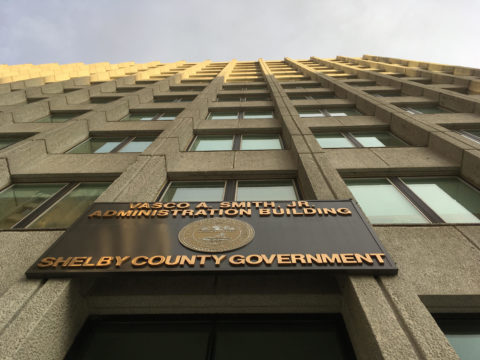In our last post, we began our list of 10 things that made us who we are today.
In that post, we listed three factors (these 10 are in no particular order):
* Shelby County Encourages Middle Income Families to Leave Memphis
* No Commitment to Planning
* Ignoring the Need for Equity
Today, we turn our attention to two more of our Top 10 list: “Lock ‘Em Up Law Enforcement” and “County Government delivers urban services.”
Lock ‘em Up Law Enforcement
Sometimes, we wonder if it’s possible for Memphis Police Department to ever have enough money.
Regardless of what kind of law enforcement issue surfaces, the answer is always the same: MPD needs more money. When you’re a hammer, all problems are a nail, but what’s most interesting about its requests for more and more money – this week it was accompanied by the old reliable threat of fewer officers and a decline in public safety – is that the requests for more money are often devoid of details about why just under a quarter of a billion dollars a year does not provide enough boots on the street to give police commanders the flexibility to do everything they want to do.
What really makes the constant budget requests puzzling is found in the city’s own five-year fiscal strategic plan, which said: “Crime reduction requires a balance between investments in prevention and policing to achieve crime reduction based on research and cost-benefit analysis. If the City chooses to continue its reliance on policing as its primary means of achieving crime reduction, it must find a way to pay for it – the current method is fiscally unsustainable…the City cannot afford the current level of police FTEs.”
Unsustainable or not, it’s the place where city government puts most of its money.
Half a Billion Dollars a Year
But the cost to city government is only half the story. The lock ‘em up answer to crime problems ripples throughout the county budget as well – and drives up the overall tax rates for city and county. Even more, they drain money that could improve quality of life and attack blight and code violations in our neighborhoods.
Shelby County Government spends roughly as much as City of Memphis does. There, it’s for enforcement, jail and prison, courts, prosecutors, public defenders, and diversion and pretrial – with a price tag of about $232 million a year.
Total cost for both governments for law enforcement and criminal justice is $478.1 million. In keeping with the local tradition of Memphians paying a disproportionate share of the costs for public services, taxpayers within the city pay about 80% of the total.
Any suggestions of reducing police budgets to provide more funding for starving city services predictably results in the public safety card being played, and it’s politically hard for legislators to raise questions without being accused of being soft on crime, thwarting any clear-eyed examination of what a balanced crime-fighting plan really looks like.
Business As Usual
This fact is indisputable: there is no clear correlation between the size of a city’s police force and its crime rate. If we’ve proven anything in Memphis, it is this. Despite a much larger police force and a significantly larger crime-fighting budget, Memphis’ violent crime rates remain stubbornly high, and because most cities’ crime rates are dropping, Memphis is running in place at the top of the major cities’ crime rate rankings.
Some cities actually reduced the size of its police department and its crime rate dropped as much as twice as much as Memphis, largely because they were also concentrating on prevention and intervention, not just suppression.
It’s why our community has to get more inventive and bold in the development of comprehensive strategies of crime prevention on both the city and county sides of the street. Vital to our success in fighting crime are more community crime prevention strategies that target changes in community infrastructure, culture, technology, and physical environment to reduce crime.
Much of that prevention and intervention could take place in parks, community centers, outreach programs, youth programs, libraries, and broadened, more effective re-entry programs, but then again, there’s no money for any of this because prevention and intervention are regularly sacrificed on the altar of suppression.
County Government Chooses Urban Services
It often seems that Shelby County Government has made many of the poor decisions that produced the problems that define our community today. The crux of many of them is linked to a decision made early after it was restructured: to deliver an urban level of services to unincorporated Shelby County.
While the intent of the restructure was to modernize county government (until then, the lines of administrative responsibility blurred between a three-person commission and the county legislative body, then called the Quarterly Court), one characteristic of the old rural-dominated government remained – an illogical attention and emphasis on the needs of the area outside of Memphis.
This dominant rural-oriented perspective came from a time when most of Shelby County Government’s legislators – then called squires – came from the much more sparsely populated small towns and rural areas of Shelby County. In fact, it wasn’t until the U.S. Supreme Court ordered the county to elect its legislative body on the basis of “one man, one vote” did county government realign its election process, and in the process, the nation received a landmark legal decision that affected every public body in the U.S. Until then, the county squires from outside Memphis outnumbered those from inside Memphis although most of the population was inside the city limits.
Rather than providing traditional county services, county government decided to dish out urban services that eroded the difference that should be implicit between municipal and county governments in the first place.
Urban Services for Rural Areas
The poster child for the decision that was made is the volunteer fire department that at the time answered all fire calls in unincorporated Shelby County. The newly minted mayor of county government chose to eliminate the volunteer department and instead create a “professional, fulltime fire department.” It was the first step down a road on which Shelby County time and time again chose to deliver what were more in line with urban services that rural or suburban services.
Soon, county government was providing ambulance service, building new schools, new roads, and new fire stations, and fighting to convince Memphis to extend sewer lines to open up greenfields for new development. Unfortunately, there was never the serious policy decision about what a municipal service and a county service should be. Instead, Shelby County Government set out in an assertive strategy to make its political base happy with urban services not previously provided in unincorporated Shelby County.
Looking back, it’s strange that there was no serious debate when greenfields were targeted for the largely derivative development that became the standard for the sprawling suburbs in unincorporated Shelby County. Starting with Hickory Hill, county government was willing to subsidize a quality of housing that would require substantial reinvestment before the first mortgage was even paid off. In Hickory Hill, Shelby County built some of the first obscenely wide roads that would become its hallmark, fueling rapid development that created even more demands for fire, roads, bridges and schools.
Blurring the Lines
Even events hailed as progressive steps forward were in truth driven by development interests, such as the extension of Gray’s Creek sewer lines in 1994, but Memphis’s faulty reasoning was that it was willing to enter into these kinds of agreements because of the assumption that they would be annexed in the future.
To quote Gene Pearson in a Smart City Memphis 2010 post: “In 1994, Memphis City Council and the Shelby County Commission ratified an agreement driven by county government called the “Balanced Growth Plan.” On the one hand, Shelby County agreed to provide money to Memphis to help in revitalization, a paltry $2 million (with Memphians of course paying the majority of it in county taxes). In return, Memphis agreed to extend sewer lines into the Gray’s Creek basin located in east central Shelby County between Arlington and Collierville and extending from western Fayette County to Cordova, and create millions of dollars in profits for developers.”
These urban services not only drove up the county property tax rate, but they also thoroughly blurred the lines that traditionally had to be crossed in a Memphis annexation. The philosophy of governance is that people who move to rural or suburban areas receive a lower level of services, and if they want a higher level of service, they become part of an urban area. Here, resistance to annexation became even more volatile since people in the annexation area were already receiving urban services.
Put in a sentence, if people who move out of Memphis want urban level services, they should pay for them – by being part of a city and paying the taxes that make them possible. If they live in an unincorporated area, they have made the decision to locate where a rural level of services are provided.
It’s a basic premise of government theory that got lost in the earliest days of Shelby County Government. Rather than providing a basic level of services, county government dished out urban services that eroded the difference that should be implicit between municipal and county governments in the first place.
Next Post: “The 10 Decisions That Made Us Who We Are” Continues.






Amen! Amen! and Amen!
It is much harder being a parent in a place with bad and unfunded schools. But the problem is that Republicans at all levels of gov’t have demonized taxes to the point where everyone expects low taxes and high level of service. And if it is not enough collected, then there must be a high level of fraud, waste and abuse.
Now, people in the the county expect to suck off the city without having to put anything up
Urban services for the county areas has always been a complex issue. This is mainly owing to the fact the county is already carvd up for annexation thus often services are put in new suburbs. MLGW extends the power lines and water pipes out there … that has NOTHING to do with taxes but fees for services. That is MLGW doing that … not the Shelby County gov’t nor Memphis … other than MLGW is run by Memphis.
Gov’t services … such as street lights are not found in the county suburbs. I livd out there for years and didn’t get city garbage or street lights until we were annex’d … Again, it was fees. I paid for a private service to pick up the garbage and was living well without street lights. I needed neither street lights nor city garbage pickup. I paid MLGW for light, gas, and water. If Memphis doesn’t want MLGW to afford these services to the county, then MEMPHIS needs to stop it. But as pointed out abuv … it was all part of a plan. Don’t blame republocrats or demopublicans sunderly … they both share in the blame.
If 80% of the crimes are committed in Memphis, why is it unfair for Memphians to foot that percentage of keeping (most) of the residents alive through another weekend?
Then since 80% of the county debt was driven by suburban sprawl, why isn’t it fair for residents outside Memphis to pay for all of that and for all future infrastructure to pay for more and more development?
Many suburban people do not understand that gov’t decision makers actually drive sprawl with their zoning laws. They tend to believe that it is the “free market” working. But the real question is how many people would live in Cordova and beyond if there were no roads, waterlines, sewers and other infrastructure built there? How many shopping centers would be there?
It is fair to say that without sprawl (and more investment in the urban core) that the city (and region as a whole) would be better off
The ‘real’ suburbs’ exempting Lakeland Playland require developers to install all infrastructure within their developments, and extend road improvements, et al if required to do so. Shelby county for years paved the roads in the subdivisions. Most have/should have their own law enforcement/fire/public works/sanitation, or are responsible for subbing them out.
‘cordova’ was never designed as a town (despite developer marketing ploys to the contrary) and was planned/built/overbuilt/declined in the Memphis reserve area or within the boundaries of mid Americas big new city itself.
If home buyers can’t read a map, then caveat emptor.
Anon 10:13
I think you touched on a major part of the issue when you stated “‘cordova’ was never designed as a town”. That is very true. The area (and others in Shelby County, the region and throughout the southeast) was largely built without an overall basic plan or policy for open spaces, amenities, service facilities, or institutions. Little thought was given to connecting neighborhoods, businesses, schools and amenities with each other in a way that would benefit all over a period defined by decades instead of a few years. It remains a very real reason for the area’s struggle to maintain its appeal and value. In addition, the few plans that did exist for the area- which were mostly transportation focused- were largely ignored by the powers that be.
The whole fiasco points to the fact that Shelby County government chose to do what was easy or more profitable in the short term as opposed to what was right in the long term. What we could be discussing is the degree to which those in positions of leadership were all too aware of the impact their decisions would have over the coming decades. To what degree are they culpable for the harm they have done? Should they be held legally responsible and can/should justice be pursued via something as direct as a class action lawsuit?
As noted by SCM, Memphis has the power to control zoning up to 5 miles from its corporate boundaries outside of the other municipalities, which includes most of Shelby County. Also as noted, the Memphis City Council has never had a clear policy on an efficient land use pattern, and as a result, zoned land to please the developers, not the citizens – (a few city council members have actually been paid to side with the developers).
With the recession, budget problems, and discussions about smart growth, the Memphis City Council has the opportunity to begin using it zoning power (it also regulates subdivisions up to 3 miles from Memphis) to halt sprawl, but will it?
A disturbing CA article indicates that Mayor Luttrell has a separate legislative agenda from AC Wharton to eliminate Memphis’ powers to zone and regulate subdivisions outside of its corporate boundaries. (CA 12/2/14, “Wharton Luttrell renew requests of general assembly…….” Thus the one power Memphis has to control its destiny could be eliminated. This looks like the developers fear a Memphis City Council that will look harder at sprawl than before recession due to fiscal problems caused in part by sprawl.